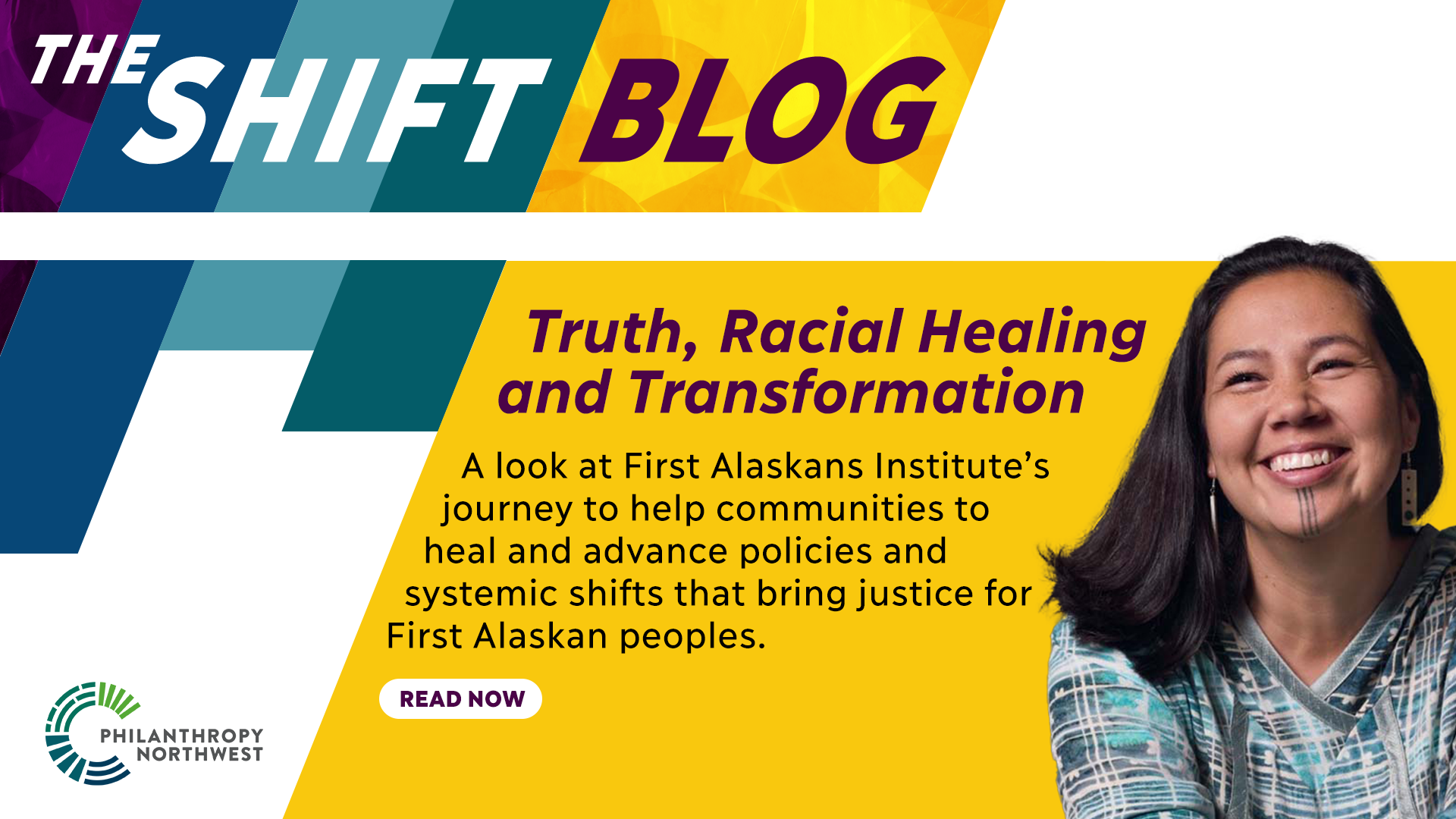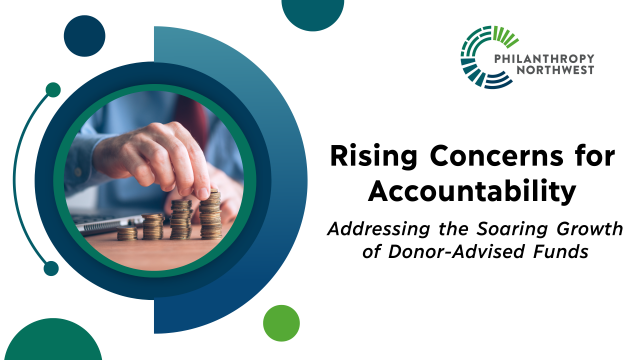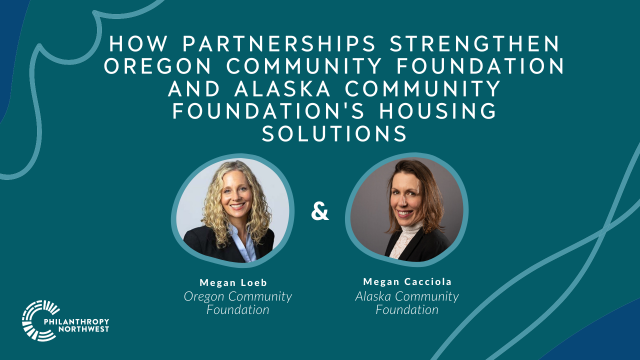
As Philanthropy Northwest continues forward in our organizational equity journey, we have continued to reckon with the importance of repair. While unearthing the roots of systemic inequities is a great first step, engaging in reparative action in partnership with harmed communities is critical to healing and moving forward. This reparative action can take many forms - financial payment, ceding power and control and truth-telling.
The First Alaskans Institute (FAI) Truth, Racial Healing and Transformation (TRHT) tribunal process was created in direct response to the call from their communities to bring to light the painfully hidden wrongs of the past that inhibit progress throughout the state of Alaska, help communities to heal and advance policies and systemic shifts that bring justice for First Alaskan peoples.
FAI has created safe spaces to grow knowledge and understanding of the ways that injustices have shadowed communities’ experiences through the institutions and systems we all participate in. They focus on centering difficult topics such as protecting Indigenous ways of life, lands and laws, uplifting truths of our boarding and residential school survivors and descendants and missing and murdered Indigenous relatives and their families.
We are honored to be in conversation with FAI’s Vice President and Philanthropy Northwest’s board member Ayyu Qassataq to hear how their work has brought their community to the precipice of truth and racial healing.
What lead FAI to engage in the Truth, Racial Healing and Transformation tribunals?
Diving right into the truth, racial healing and transformation endeavor that we have been engaged in for well over a decade at this point when I first came to FAI over 13 years ago, I would say Alaska was very much in its infancy when it came to engaging in a proactive and productive way about issues of race and racism. So often what would happen in that period is that the only time we would discuss racism is if something really horrible occurred. What you would see is that our community would rise and would call foul at these experiences that we would speak out against how unjust these things were. But it would often be met with a polarizing kind of force that would say “Oh you’re just, you know, making a big deal out of nothing.” Things that would minimize what our experiences were.
When I came to FAI, we had just gotten word that we had received the funding for a multi-year grant from the W.K Kellogg Foundation as part of their America Healing Initiative at the time. It was intended to reset the dialogue and race in Alaska by having a race dialogue in Alaska. We wanted to harness the timeline knowing that in two years, Alaskans would be asked on the ballot shall there be another constitutional convention. We were using that as an opportunity to kind of catalyze a conversation asking what a racially diverse constitutional convention would look like. What would that sound like? How could our constitution be different if it included the voices of our rich diverse peoples of Alaska?
What we found was that it certainly was an effective mechanism to bring people to the table in a proactive way. Folks were really interested and eager to engage in a conversation about racism in a good way. Then we created what we called a Visionary Council and a host group. The Visionary Council was comprised of very diverse community leaders, visionaries, culture bearers, etc, from all different cultural groups who could help us think big, and think through the challenges that would surely come having conversations about racism in Alaska, we created a host group of roughly 20 to 40 diverse young leaders, who were interested in learning how to host conversations about racism using indigenous methodologies, so that they could help be kind of an extension of having conversations in Alaska in a different manner.
The original intent with the tribunals was that we wanted to approach making a safe space for our truths to be told in a way that is really loving and reflective of our people. One of the reasons that we have engaged in this process versus many of you may be familiar with truth and reconciliation, is that truth and reconciliation processes, though they really do come from a place of wanting to make space for truths to be told, we felt it was very important to not perpetuate a false narrative that we're reconciling to a time in the past, where things were good that we were in good relations. That has never been the truth of Alaska Native peoples and those who have come. It is about creating the honest space for our truths but doing it in a way that's loving and acknowledges that when these truths come out, there's a very deep pain and trauma that is shared.
How did the impact of the grant expand?
The original intent of the grant was to host three dialogues that were increasing in size over the course of the three years. However, it was just so incredibly clear that there was such a hunger and a need to have these conversations concurrently, all over the place. There just really needs to be a different dialogue about our experiences as indigenous and BIPOC peoples. So rather than the three dialogues, what we ended up having was 54 dialogues all over the state. It really did create a snowball effect where the need just continued to grow. Throughout that time, we were also really homing in on methodologies that were centered in our indigenous values, and ways of holding these difficult conversations in a good way that invited everyone to the table and their truth to the table.
When we were leaning into what the next phase of that work could be, it was very clear that we also needed to put more focus and attention on the institutional and systemic nature of racism and how it shows up. Moving into our second phase, we were really focused on how we can help advance shifts, change and greater awareness around racism when it comes to the education system, our child welfare system and the media.
In our second phase, we were very intentional about the ways that we engaged within these three different realms. We traveled around to different school districts in the state, really engaging in a conversation with educators about what this can look like.
We did spend a lot of time intentionally building relationships with our media family, engaging them in these important dialogues and helping them to think about issues of race in a different kind of way. The things you learn in school, the things you learn in museums, the prevailing narrative in society, is that Native peoples have all these benefits. If you are failing, it must be because something is wrong with you. We found that as we created space for the truths of our people, it just was so vital and important for more Alaskans to understand the true histories that have shaped this place, so that not only can you understand the challenges that are people's experience, but also that finally, we can collectively see how strong and resilient our people are, and always have been. How incredibly brilliant, beautiful, funny and amazing, our people are. Growing up here, you do not often get that bright light shined on how amazing our Alaskan Native community really is. There is so much richness and so much more to the story.
And then we really leaned into our work within the child welfare system. At the time, the commissioner of the Department of Health and Social Services was Valerie Davidson, who also serves as a trustee for Vishal Oskins Institute. She was overseeing the Office of Children's Services (OCS) over the child welfare system in the state. She recognized how harmful the system continues to be in terms of being in good relationships with others who care deeply about our kids and our families. She pulled us in to then bring together OCS workers ICWA workers in the Child Welfare Act workers within our tribes and nonprofits who had been really stepping in and helping to protect our children and families. And that became an effort that grew over the years where we just increasingly brought in more and more voices and thinking around that and ultimately culminated in the OCS department having its first ever five-year strategic plan, which included a vision that native children belong with into families, and that OCS as a department will be able to further its mission best by working closely with tribes and upholding tribal sovereignty when it comes to working with our tribes, which then led to the first-ever tribal compact over child welfare, where the governor signed a contracting agreement which allowed for the funding that would have otherwise come to the state for OCS, child welfare services to go to the tribes that wanted to take over those services themselves.
What is on the horizon for FAI when it comes to the TRHT work and how can Philanthropy support Native Peoples?
As we move into this next phase of TRHT by having a conversation about racism and engaging in institutions, we wrestle with systems and the way that racism perpetuates through them. A common thread through all of these is that there are so many of the truths of our people's experiences that have been suppressed, that have been hidden and that has not been taught in schools. We now have generations of Alaskans who only have part of the story about the history of our state. Particularly I will speak to the challenges in our native community, we see these challenges out of context, for what created them. There is no context to help you understand why things are the way that they are. Helping to make space for those truths to be told was an important part of what the next phase would be.
We are actively trying to decolonize our institution while doing this work, and we learn a lot from our mistakes as we go, but we are really committed to the decolonization work and the indigenizing work because we know that that is an important part of our healing. I wanted to just kind of bring in a touch point related to philanthropy, and what racial healing can look like in a philanthropic lens. How much work there is yet to be done in our sector to encounter and more critically analyze where our funders have gotten their wealth from even simply asking the question as an institution, “How has our institution benefited from the theft of indigenous lands? How has our institution benefited from the theft of African labor?” Then also engaging in, “How has my institution benefited from the oppression of BIPOC peoples, historically, and currently?” Engaging in some of these questions can be deeply uncomfortable. But also, it is vital, because I believe that everyone who engages in our sector does so because they want to be a force that heals, they want to be a force that supports the wellness and thrival of our communities.
And so, something that I value about the work that I get to do on the board of Philanthropy Northwest is really engaging in these conversations about reparations, engaging in conversations about healing, about equity, leaning into what is our role as an institution to be able to help raise awareness about these issues. .4% of philanthropic dollars go to indigenous communities in the United States. As a sector, we have a lot of work to do, when it comes to leaning into our own histories, whether we represent foundations, family, foundations, community foundations, whether we represent bank dollars, or other forms of grants, really engaging in a conversation about what the history is of how we have come to have this generational wealth in the first place.
Interested in learning more about how philanthropy can navigate the shift toward racial healing, reconciliation and repair? Join us for our new, virtual, learning series: The Shift - Moving Philanthropy Towards Reparative Action.


